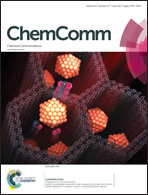Supramolecular electrode assemblies for bioelectrochemistry
Abstract
For more than three decades, the field of bioelectrochemistry has provided novel insights into the catalytic mechanisms of enzymes, the principles that govern biological electron transfer, and has elucidated the basic principles for bioelectrocatalytic systems. Progress in biochemistry, bionanotechnology, and our ever increasing ability to control the chemistry and structure of electrode surfaces has enabled the study of ever more complex systems with bioelectrochemistry. This feature article highlights developments over the last decade, where supramolecular approaches have been employed to develop electrode assemblies that increase enzyme loading on the electrode or create more biocompatible environments for membrane enzymes. Two approaches are particularly highlighted: the use of layer-by-layer assembly, and the modification of electrodes with planar lipid membranes.



 Please wait while we load your content...
Please wait while we load your content...